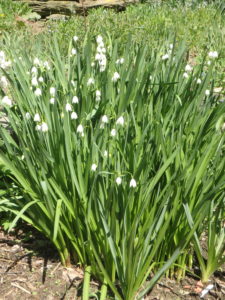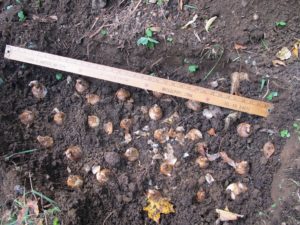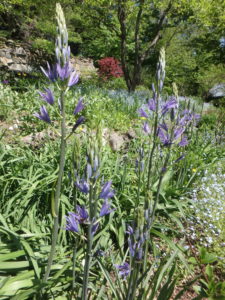It’s Time to Plant Bulbs for Spring Blossoms
This is the season for planting bulbs – from mid-October until the snow flies. Actually, I’ve shoveled snow off a bed to plant bulbs in November, and they did fine. Bulbs have everything inside them needed to succeed their first year. If you want them to keep on thriving, they will generally need plenty of sunshine, good drainage – and you must not cut off the foliage before it starts to die back.
That said, there are exceptions. The small bulbs like snowdrops, crocus, scilla and glory of the snow are fine in the shade of deciduous trees. That’s because they will bloom early and re-charge themselves before the trees get dressed in leaves that will shade their beds. No bulbs that I know of thrive in the shade of pines, hemlocks or other conifers.
Deer can be a problem for some sorts of bulbs. Tulips are tasty to them, and many a gardener has wept tears of frustration when the deer ate their tulip buds the night before they were to open. Repellents can work – my aging corgi, Daphne, is still a great deterrent – but there are commercial repellents as well.
Garlic, soap, coyote urine and nasty repellents made with rotten eggs and blood meal can keep deer away – unless they are really hungry, or just plain mean. If deer are a problem, you can protect bulbs with wire mesh. No need to build an 8-foot fence, just build a dome or cage over them using chicken wire.
Squirrels, mice, voles and chipmunks can eat bulbs. Some folks buy cheapo hot pepper powder to sprinkle in the bulbs, but it is probably only good for one season. You can put sharp cinders or oyster shell meal (sold at feed and grain stores for chickens) into the hole at planting time. Alternatively you can feed the rodents all winter, or catch and deport them in a Hav-a-Hart trap. Peanut butter with a sprinkling of sunflower seeds will attract them to your cage. They can’t resist.
In the past I have always planted 25 to 50 bulbs in a hole at once. I dig to the appropriate depth, loosen the soil at the base, add some fertilizer and scratch it in. Usually I just use a slow-release organic fertilizer like Pro-Gro, but there are mixes made specifically for bulbs, often called Bulb Booster. I place the bulbs in the hole, pointy end up, and fairly close together. I plant bulbs closer than the directions say – and no bulb has ever complained.
I recently attended a presentation on bulbs by a Dutch expert, Jacqueline van der Kloet. She proposed random plantings. She showed slides of wheelbarrows filled with bulbs of various types, sizes and bloom dates. She mixed them together and then tossed them out onto a flower bed for planting. Her people used trowels to plant every bulb individually. That seems like a lot more work, but the look in spring was interesting.
On a recent Sunday I gave random planting a try. We had 25 daffodils, 150 crocus of various types and 6 big alliums. The bed for the bulbs was about 2 feet wide and 10 feet long. The soil is very rich and fluffy, so planting was easy. Even with a fruit tree and 4 peonies in the bed there was room for the bulbs. We will plant annuals in that bed, come June, so we may inadvertently disturb some of the bulbs when we do that.
Instead of using a trowel to plant, I pulled back the soil with a curved hand tool with a single-tine called the CobraHead weeder. For crocus, planting was easy: they only need to be 3 inches deep. To get down 6 inches for the daffodils and allium, I needed to use my fingers to keep the loose soil from falling into the planting hole as I prepared it. Still, it went along quite quickly.
Most bulbs don’t like soil that is constantly wet. Much of my property is on the flood plain of a little stream, and in winter and spring does stay quite moist. In the past I have had good luck in the moist areas with Camassia (Camassia sp.), Summer Snowflake (Leucojum aestivum) and some daffodils. I have done tulips there, too, but in raised beds to improve drainage.
Camassia is a lesser known flower, generally in shades of blue or white. The stems are about 18 inches tall, with many florets along the top part of it. They bloom in May or June and hold up well on the stem and in a vase.
Summer snowflake has tall white flowers that resemble snowdrops on steroids: they are on stems that are 12 to 18 inches tall, and each stem has 3 or 4 flowers. I got 25 bulbs about 20 years ago, and now have a huge clump each spring. They bloom in mid-May for me.
Ms. van der Kloet recommended two varieties of daffodils that do well in damp soil: Jenny and Thalia. Thalia I have grown: it’s a nice white one, and fragrant. My recommendation for gardeners with moist soil? Add lots of compost to the soil, including under the bulbs, and raise the beds as much as possible. Even 4 to 6 inches will help. But if you have truly soggy soil, your bulbs may rot, so experiment before planting in large numbers.
Winter is long, and I want something to look forward to. Spring bulbs are worth every penny I spend on them. And if a few get eaten by rodents or succumb to soggy soils? So be it. I will always have plenty to enjoy.
Henry Homeyer is a gardening coach, speaker, and consultant and is the author of 4 gardening books. He can be reached at henry.homeyer@comcast.net.





